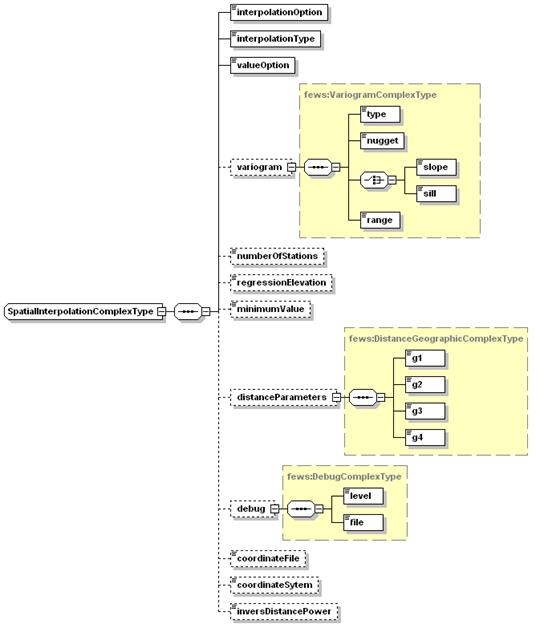...
- Filling of gaps with a default value
- Filling of gaps by linear interpolation
- Filling of gaps by block interpolation
- Extrapolation of gaps at start or end of a time series
All these methods can be configured to only fill gaps that are not more than of a given duration. Essential to the understanding of the Interpolation module is that the module does not have the capability to identify gaps due to potentially unreliable data in a time series. It will only provide an alternative value for those data points of which the quality flag is set to Unreliable. The validation module can be configured to identify unreliable data and set quality flags as appropriate.
...
- spatial interpolation using Kriging
- spatial interpolation using Inverse Distance Weighting
- spatial interpolation using bi-linear interpolation
- Averaging of grid cells within a sub-basin boundary
- Averaging of grid cells within a sub-basin boundary using XML data
- spatial interpolation using clossest distance
- input average times output Area
- renk a Cline Triangulation
- Sum of grid cells within a sub-basin boundary.
When available as configuration on the file system, the name of the XML file for configuring an instance of the interpolation module called for example InterpolateHBV_Forecast may be:
...
- interploationId : Id of the interpolation defined. Used for reference purposes only. This Id will be included in log messages generated.
serialInterpolation
Root element for the definition of serial interpolation options.
spatialInterpolation
Root element for the definition of spatial interpolation options.
timeSeriesInputSet
Input time series set. Note that when the interpolation module is used to fill gaps in time series the input time series set is the same as the output time series set. The time series sets may include either a single location or a locationSet. Note that the latter may not always be possible when using the "default" interpolation option, as the default may be location specific.
With spatial interpolation it is possible to interpolate from a grid to a longitudinal profile.
outputSet
Output time series set. Note that when the interpolation module is used to fill gaps in time series the input time series set is the same as the output time series set. Identification is only required when the series generation option is used in spatial interpolation. The locations defined in this timeSeriesSet, and their geographical attributes, determine the locations of the series generated.
| Anchor | ||||
|---|---|---|---|---|
|
| Anchor | ||||
|---|---|---|---|---|
|
The serial interpolation option is used to define interpolation options for filling gaps in the time series identified. Multiple methods of interpolation may be identified. These will be executed in order of definition for the same time series (e,g, first linear interpolation, then an extrapolation and finally filling remaining gaps with default values).
Figure 55 Elements for defining serial interpolation options in the Interpolation module configuration.
...
- linear ; for linear interpolation between available values
- block ; for block interpolation (note: the last available value is then used until a new value available).
- extrapolate ; for extrapolation at start or end of series. Extrapolation uses the last or first value to fill the gaps at the end or start of the series.
- default ; for replacing unreliable values with a default.
gapLength
Maximum gap length of unreliable data in seconds which will be filled using the interpolation option defined. If the gap is longer, then none of the values will be replaced.
defaultValue
Default value to use to replace interpolation values.
| Anchor | ||||
|---|---|---|---|---|
|
| Anchor | ||||
|---|---|---|---|---|
|
The serial interpolation option is used to define interpolation options for filling gaps in the time series identified using available data from other (spatially distributed) locations. This method can be used to either fill gaps, or to create a new time series.
Figure 56 Elements for defining spatial interpolation options in the Interpolation module configuration.
...
- inversedistance ; for inverse distance weighted interpolation between available values at spatially distributed locations.
- bilinear ; for bilinear interpolation between available values at spatially distributed locations.
- kriging ; for interpolation using Kriging between available values at spatially distributed locations.
- gridcellavaraging; for interpolation of time series based on averaging grid cells (used for example for establishing catchment averages where the catchment size is much larger than the grid cell size).
- Closest distance; for interpolation of time series based on the closest distance between available values at spatially distributed locations.
interpolationType
Specify if spatial interpolation is used for filling gaps in series or for generating a new series. Note in the latter case the output variable will need to be defined. This also defines if the output variable is a grid time series or a scalar time series Enumeration of available options is;
- seriesfilling ; for filling gaps in time series (scalar time series only).
- seriesgeneration: for creating a new time series.
...
- normal ; for using values as is.
- residual: for applying linear regression first and applying spatial interpolation on residuals of values only.
- splitwithelevation; for applying different linear regression parameters above and below an elevation split (required only when elevation is considered).__
variogram
Root element for the semi-variogram to be used when Kriging is applied.
variogram:type
Type of variogram to be used. Enumeration of available options is;
- exponential ;
- Gaussian ;
- Linear ;
- Spherical ;
- _power
_
...






